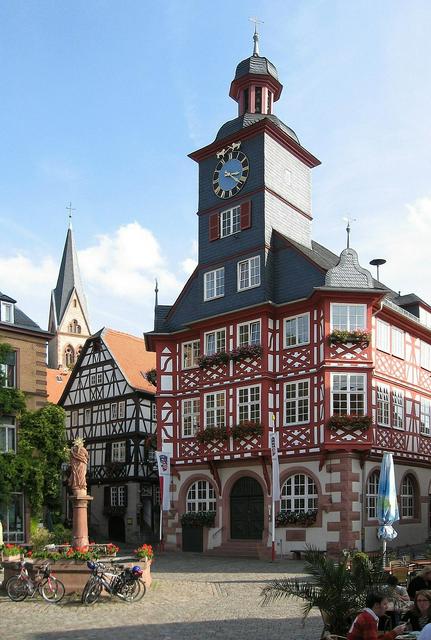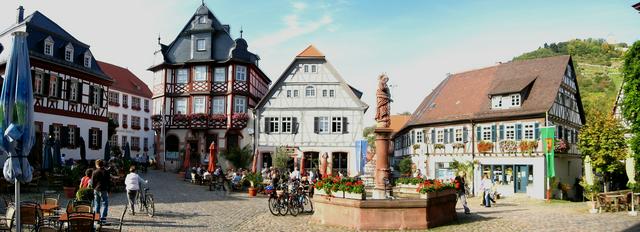 Heppenheim is a town in South Hesse, Germany along the Bergstraße, a mountain road running on the western edge of the Odenwald mountain range.
Heppenheim is a town in South Hesse, Germany along the Bergstraße, a mountain road running on the western edge of the Odenwald mountain range.
Heppenheim is in an old wine-growing region. Impressive half-timbered buildings in the old town area (Altstadt) still testify to the town's former heyday.
The Marktplatz, the centre of the old town area (Altstadt), is situated at the top of hill with many half-timbered houses on its slopes occupied by local residents. Thus, most of the Altstadt is a residential area with several restaurants but almost no shops. The shopping district is located just outside of the Altstadt on Friedrichstraße, a pedestrian mall.
The tourist office on the Marktplatz is closed on Sunday, and also on Saturday between November and February.
 Half-timbered Altstadt Heppenheim has a largely preserved, picturesque old town centre with many timber-frame houses. Some small remnants of the city wall have been preserved. Streets and squares in the Altstadt include: Marktplatz (Market Square); Marktgasse (Market Street); Schunkengasse; and Kleine Bach. Siegfriedstraße is a street outside the Altstadt along its north side, it has a number of half-timbered buildings intermixed with more modern structures.
Half-timbered Altstadt Heppenheim has a largely preserved, picturesque old town centre with many timber-frame houses. Some small remnants of the city wall have been preserved. Streets and squares in the Altstadt include: Marktplatz (Market Square); Marktgasse (Market Street); Schunkengasse; and Kleine Bach. Siegfriedstraße is a street outside the Altstadt along its north side, it has a number of half-timbered buildings intermixed with more modern structures.
- Marktplatz. with the Marktbrunnen (market fountain) surrounded by half-timbered buildings. The tourist information is located on the east side between the streets Schurkengasse and Kirchgasse.
- Rathaus. was built in 1561. After the city fire of 1693, only the stone hall on the ground floor remained. The baroque half-timbered Rathaus was rebuilt in 1705/06. The carillon was installed in 1958 following a fire in the tower.
- Liebig Apotheke. The renowned chemist Justus von Liebig completed his apprenticeship here. During one of his experiments with chemicals, the roof burned down and Liebig then lost his job as an apprentice.
- Starkenburg. In 1065 a fortified castle (Burg) was built for the monastery of Lorsch. Today, the castle is used as a youth hostel. The large tower can be climbed on Sundays upon request. Two smaller towers are accessible. There are restaurants at the castle. Access is via a steep cobblestone road allowing automobile access for 3/4 of the way.
- Pfarrkirche St. Peter. This imposing parish church is called the "Cathedral of the Bergstraße". The Church was built between 1900 and 1904 in the neo-Gothic style.
- Museum für Stadtgeschichte und Volkskunde. The timber-framed building was built in 1239 and today houses a collection on town history.
- Feuerwehrmuseum. The garden in front of the museum has model trains and many miniature models of fire fighting equipment.
- Postbrunnen. is a fountain to commemorate the pioneer Turn and Taxis postal service that had a halt in Heppenheim. The plaque for the fountain also commemorates that the German writer Johann Wolfgang von Goethe once visited Heppenheim.
- Erich H. Barth. art director at the University of Guelph, Ontario, Canada has a fountain in his honour . Barth was raised as an orphan in Heppenheim and emigrated to Canada in 1953.
- Heppenheim (Bergstr) station. The railway station building was built between 1845 and 1846 in the neo-classical style. The Hessian heritage office lists the building as an early railway station of outstanding historical significance. The station was modernized in 2004 and the platforms still serve rail travelers.
Marktplatz. with the Marktbrunnen (market fountain) surrounded by half-timbered buildings. The tourist information is located on the east side between the streets Schurkengasse and Kirchgasse.
Rathaus. was built in 1561. After the city fire of 1693, only the stone hall on the ground floor remained. The baroque half-timbered Rathaus was rebuilt in 1705/06. The carillon was installed in 1958 following a fire in the tower.
Liebig Apotheke. The renowned chemist Justus von Liebig completed his apprenticeship here. During one of his experiments with chemicals, the roof burned down and Liebig then lost his job as an apprentice.
Starkenburg. In 1065 a fortified castle (Burg) was built for the monastery of [[Lorsch]]. Today, the castle is used as a youth hostel. The large tower can be climbed on Sundays upon request. Two smaller towers are accessible. There are restaurants at the castle. Access is via a steep cobblestone road allowing automobile access for 3/4 of the way.
Pfarrkirche St. Peter. This imposing parish church is called the "Cathedral of the Bergstraße". The Church was built between 1900 and 1904 in the neo-[[Gothic]] style.
Museum für Stadtgeschichte und Volkskunde. The timber-framed building was built in 1239 and today houses a collection on town history.
Feuerwehrmuseum. The garden in front of the museum has model trains and many miniature models of fire fighting equipment.
Postbrunnen. is a fountain to commemorate the pioneer Turn and Taxis postal service that had a halt in Heppenheim. The plaque for the fountain also commemorates that the German writer Johann Wolfgang von Goethe once visited Heppenheim.
Erich H. Barth. art director at the University of Guelph, Ontario, Canada has a fountain in his honour . Barth was raised as an orphan in Heppenheim and emigrated to Canada in 1953.
Heppenheim (Bergstr) station. The railway station building was built between 1845 and 1846 in the neo-classical style. The Hessian heritage office lists the building as an early railway station of outstanding historical significance. The station was modernized in 2004 and the platforms still serve rail travelers.
The shopping district is located on Friedrichstraße, a pedestrian mall outside of the Altstadt. The shopping district seems to shut down at 6 PM. Just off Friedrichstraße there is the drugstore Drogeriemarkt Müller with an extended range of products. There is an organic food store (BioMarkt) on Marktstraße in the Altstadt.
There are several restaurants along Marktstraße and on the Marktplatz within the Altstadt. There are cafes along Friedrichstraße in the shopping district but these tend to close around 6 PM. There are some pizza and donar restaurants along streets crossing Friedrichstraße that stay open later.
Tchibo is a retail clothing chain with each store containing an espresso bar. One store of the chain boasted that Tchibo espresso coffee is better than in Italy! At the very least, Tchibo coffee is good. The main problem with Tchibo is that their stores offer little or no space to sit down to enjoy your coffee. However, at the store on Friedrichstraße in Heppenheim, although space is tight, there is a little more space than at most Tchibo locations to enjoy your coffee while seated.
Other places along the Bergstraße are:
